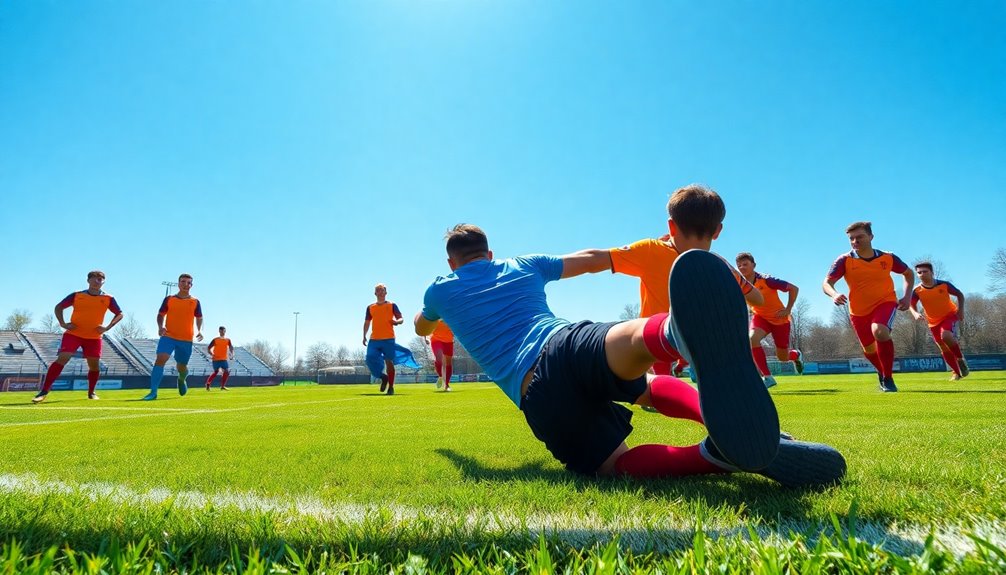
11v11 Soccer Positions Explained for Coaches and Players
March 11, 2025In 11v11 soccer, each position has unique responsibilities that are essential for teamwork and success. The goalkeeper guards the net, defenders stop attacks, and midfielders orchestrate play, linking both offense and defense. Forwards focus on scoring goals by creating chances and putting pressure on the opposing team. Understanding these roles helps enhance your team's performance and cohesiveness on the field. As you explore different formations and strategies, you'll uncover more insights on maximizing your team's potential.
Understanding the Goalkeeper's Role (#1)
The goalkeeper is the backbone of a soccer team, playing a pivotal role in defense. As the only player allowed to use their hands in the penalty area, you're essential in preventing goals. You need agility and quick reflexes to stop shots and read the game effectively. Communication is key; you must direct your defenders and maintain defensive formations during play. Additionally, you should also be aware of your defensive structure to ensure that your team remains organized under pressure.
Collecting the ball from the ground and handling close-range shots is important, as is distributing the ball to launch counterattacks. Your training focuses on catching, diving, positioning, and making decisions under pressure, which are critical for enhancing your overall performance. Additionally, you must adhere to the 6-second rule to ensure fair play when controlling the ball. Understanding goalkeeper box rules will also help you navigate your area more effectively.
Embrace your role, and you'll be the last line of defense that keeps the team competitive.
The Importance of Right and Left Defenders (#2 and #3)
Goalkeepers rely on their defenders to maintain a solid backline, and that's where Right and Left Defenders come into play. These defensive players are fundamental for both stopping opposing attacks and supporting your team offensively.
When your team has possession of the ball, these players should push forward, overlapping with midfielders to create width and provide crossing options. Their speed and 1v1 tackling skills are critical in battling agile wingers. Mastering tackling skills is essential for effective defensive play, requiring proper timing and a low center of gravity. Additionally, employing a defensive stance allows them to react quickly to changing situations on the field.
However, it's essential for them to maintain positional discipline, balancing defensive duties with offensive contributions. Effective communication and coordination with center backs will guarantee a cohesive defensive unit, allowing you to cover wide areas efficiently while minimizing counterattack risks. Proper spacing is crucial to prevent vulnerabilities during transitions.
Embrace their importance to your overall strategy!
Center Defenders and Their Responsibilities (#4 and #5)
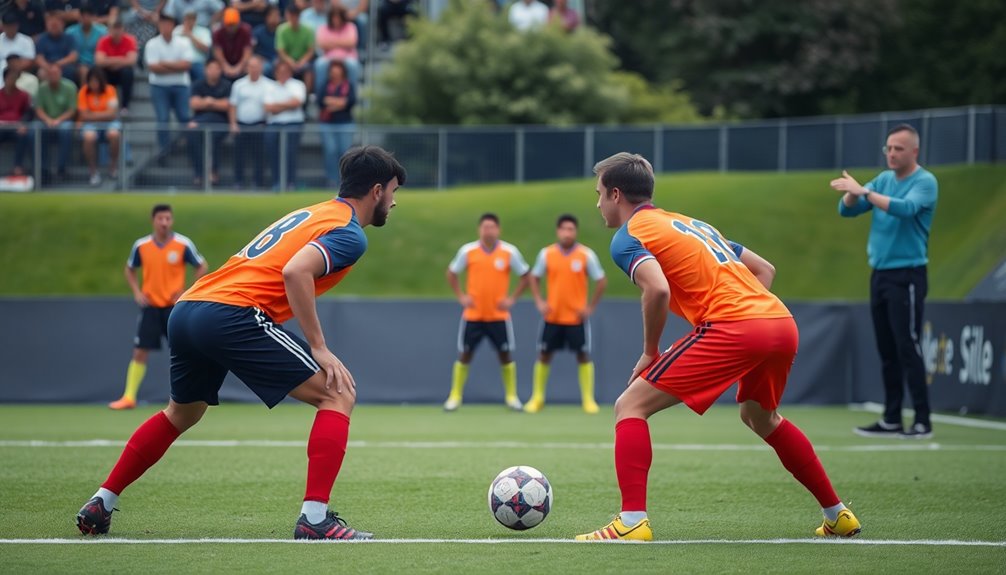
Center defenders play a crucial role in your team's defensive organization and structure. With their aerial ability and strength, they excel at winning headers and thwarting opposing attacks. You'll rely on them not just for physical presence but also for smart decision-making to keep the defense solid. Effective communication is crucial for organizing the defensive line to ensure cohesive teamwork and minimize gaps for attackers. Additionally, their ability to effectively disrupt opponent attacks is essential for maintaining defensive integrity and supporting the overall team strategy. Incorporating regular practice of defensive stance drills can significantly enhance their individual skills and overall team performance.
Defensive Organization and Structure
While playing an essential role in a soccer team's defensive organization, center defenders (#4 and #5) serve as the backbone of the backline. They're responsible for thwarting opposing attacks and clearing the ball from high-pressure situations.
Effective communication with each other and the goalkeeper is critical for maintaining the defensive structure within your formation. You'll need to cover against through balls and overlapping runs, ensuring everyone's on the same page.
Decision-making is vital; know when to challenge for the ball and when to fall back. Additionally, center defenders can shift play by delivering smart passes to the defensive midfielder, helping initiate counter-attacks and turning defense into offense.
Master these responsibilities, and you'll strengthen your team's overall defensive strategy.
Aerial Ability and Strength
A strong aerial presence is essential for center defenders (#4 and #5) as they frequently encounter high balls and crosses from opposing attackers. Your aerial ability allows you to effectively contest these situations, ensuring you can clear threats and maintain defensive integrity.
Alongside this, your strength plays a significant role; it helps you hold your ground during physical challenges and win those critical 1v1 duels against forwards.
In set-piece situations, center defenders must excel both defensively, marking attackers, and offensively, contributing to corner kicks or free kicks.
Strong communication skills are important, too, as you'll organize your defensive line and guide teammates.
Finally, good decision-making is key to know when to tackle or maintain your position to thwart attacks.
Role of the Central Defensive Midfielder (#6)
The Central Defensive Midfielder (#6) plays a pivotal role in a team's structure, as they disrupt the opponent's attacks by intercepting passes and tackling players before they reach the defensive line.
This position demands discipline and tactical awareness, allowing you to maintain balance between defense and offense. You'll often find yourself just in front of the backline, providing essential defensive cover while linking defenders and attacking players. A strong understanding of defensive solidity is crucial for effectively organizing the team during defensive transitions. Additionally, incorporating core strength exercises into your training can enhance your ability to maintain balance and stability during challenges.
Strong passing abilities are vital; you need to connect with teammates and create safe outlets without risking possession.
Physical fitness and stamina are equally important, as you'll cover significant ground, supporting both defensive and offensive roles throughout the match. Additionally, understanding the importance of positional awareness enhances your effectiveness in both breaking up plays and transitioning the ball to attackers.
Center Midfielder's Impact on Gameplay (#8)
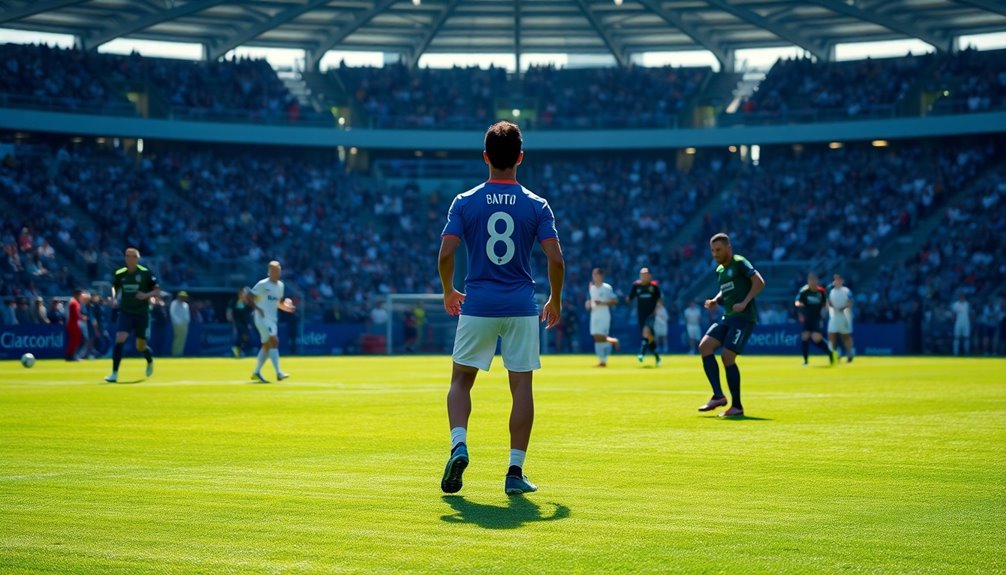
As you step into the role of Center Midfielder (#8), you'll find yourself at the heart of the game, orchestrating play and linking defense to attack.
Your primary roles and responsibilities include effective ball distribution and maintaining possession, which are crucial for shifting play. You'll need excellent stamina and endurance, covering significant ground to support both defensive and attacking efforts. In a standard match, you will be one of the 22 players on the field, showcasing your skills alongside your teammates. Developing your technical abilities is key to becoming a more effective center midfielder.
As a strong passer, you'll create scoring opportunities with accurate, strategic passes to forwards and wingers. Positioned between the defensive midfielder (#6) and the attacking midfielder (#10), you're in a prime location to exploit gaps in the opponent's formation.
Your versatility allows you to adapt between defensive and attacking roles, making you essential in various phases of the game. Additionally, mastering passing accuracy enhances your ability to execute precise passes that can break down defensive lines and facilitate scoring chances. Understanding your role as a center midfielder also contributes to the overall team success by fostering effective collaboration with your teammates.
Right and Left Midfielders/Forwards (#7 and #11)
While you mightn't always be in the spotlight, playing as a Right Midfielder (#7) or Left Midfielder (#11) is essential for your team's success.
As a right or left midfielder, your role is to provide width, stretching the opponent's defense and creating space for players operating with the ball in the center. You'll often deliver crosses into the penalty area, aiming to assist your strikers in scoring goals.
Strong dribbling skills and pace are important for taking on defenders in one-on-one situations. Additionally, you'll need endurance to shift between attacking and defensive duties.
Quick switches in play and accurate long passes will help exploit gaps in the opponent's formation, making you a significant part of your team's strategy.
The Attacking Midfielder's Contribution (#10)
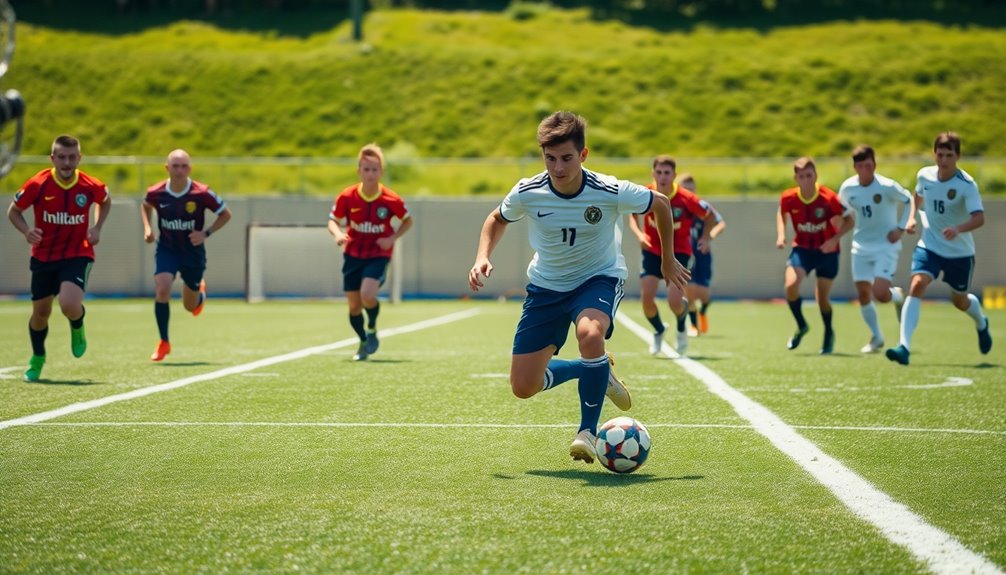
As an attacking midfielder, or #10, you play an essential role in your team's offense.
Your responsibilities include creating scoring opportunities, positioning yourself strategically, and understanding how your movement impacts team dynamics.
With your vision and skills, you can be the key to unblocking defenses and driving your team forward.
Key Responsibilities and Skills
The Attacking Midfielder, often referred to as the #10, plays an indispensable role in transforming midfield control into goal-scoring opportunities.
This player links midfield and forwards, creating chances through precise passing and keen vision. With a high soccer IQ, you can read the game effectively and exploit defensive weaknesses.
Your exceptional dribbling skills help you maneuver through tight spaces, maintaining possession under pressure.
Besides creating chances, you're expected to contribute defensively by pressing opponents and recovering the ball when possession is lost.
Strong communication skills are essential, as you must coordinate plays and relay information between midfield and the attacking lines.
Embracing these responsibilities guarantees you excel in this crucial player role.
Positioning and Movement
Positioning and movement are essential for an attacking midfielder (#10) since they directly impact a team's ability to create scoring opportunities.
As a key playmaker, you need to master the following:
- Exploit Spaces: Position yourself between the midfield and forward lines to find gaps.
- Support Changes: Facilitate quick changes from defense to attack by linking play effectively.
- Anticipate Movement: Read the game well, anticipating your teammates' runs to deliver precise passes.
- Dribble Under Pressure: Develop strong dribbling skills to navigate tight defenses and maintain possession.
Impact on Team Dynamics
While you're on the pitch, your role as an attacking midfielder (#10) can greatly shape the team's dynamics.
In various soccer formations, like the popular 4-2-3-1, you play centrally, linking the midfield and the forward line. Your exceptional vision and creativity allow you to make incisive passes, finding space between defenders.
As you draw defenders out of position, you create opportunities for wingers and strikers to exploit gaps. Players tend to rely on your dribbling skills and ability to take on defenders, which not only helps in scoring but also assists in goals.
This flexibility in your style of play fosters quick shifts from defense to offense, markedly enhancing the team's overall offensive capabilities.
Central Forward: The Key to Scoring (#9)
Central Forwards, often known by their jersey number #9, play an essential role in a soccer team's success by focusing on scoring goals. As a central forward, you're not just a scorer; your impact extends throughout the field.
Here are key aspects of your role:
- Finishing Skills: You need to capitalize on scoring opportunities with precision.
- Quick Decision-Making: Evaluating plays rapidly is fundamental for success.
- Teamwork: Collaborating with wingers and midfielders enhances offensive strategies.
- Defensive Contribution: Applying pressure on defenders helps initiate plays.
To excel, maintain your physical fitness and agility, allowing you to navigate tight spaces and exploit gaps.
Your ability to work closely with teammates is essential for effective teamwork and achieving those all-important goals.
Exploring Different Soccer Formations
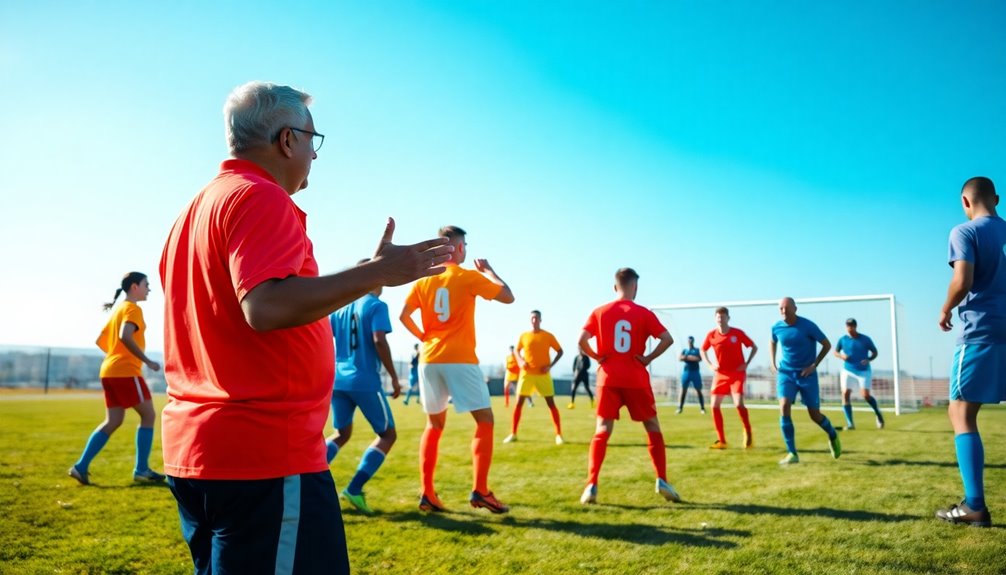
When you look at soccer formations, you'll notice a range of setups that teams use to maximize their strengths.
Each formation, like the 4-4-2 or 4-3-3, offers unique tactical advantages and requires specific player skills.
Understanding these formations helps you appreciate how coaches adapt their strategies based on the match and their team's characteristics.
Formation Types Overview
Understanding different soccer formations is essential for grasping how teams strategize on the field. Each formation serves a unique purpose, balancing the roles of defenders and midfielders while impacting overall gameplay.
Here are some popular formations:
- 4-4-2: Traditional setup with four defenders and four midfielders, offering balance but can isolate strikers.
- 4-3-3: Emphasizes a strong midfield presence and multiple attacking options through three forwards.
- 4-2-3-1: Flexible structure with four attackers, focusing on width from wingers, adapting to both offensive and defensive styles.
- 3-5-2: Features five midfielders for possession, but risks defensive vulnerabilities if overcrowded.
Tactical Adaptations Explained
Having explored various soccer formations, it's clear that teams must adapt their tactics to maximize their effectiveness on the field.
Understanding formations like 4-4-2, 4-3-3, and 4-2-3-1 helps you align your strategy with player strengths and game situations. For instance, the 4-3-3 formation promotes quick ball movement and a strong midfield, while the 4-4-2 provides balance but might leave strikers isolated.
Tactical flexibility is essential; you should be ready to shift formations, like altering from a 4-1-4-1 to a 4-3-3, based on the match's flow.
Encourage your players to grasp their roles within any formation you choose, as this understanding fosters teamwork and enhances overall performance on the field.
Coaching Strategies for Effective Player Development
Effective player development hinges on a few key strategies that can transform young athletes into well-rounded competitors.
Here are four essential coaching strategies to enhance player development:
- Rotate Positions: Allow players to experience various positions during non-competitive settings, helping them discover strengths and improve versatility.
- Simplify the Game: Clearly define roles and responsibilities for younger players, which enhances their understanding and execution of strategies.
- Tailor Coaching: Align your coaching strategies with individual player strengths to boost performance and tactical effectiveness.
- Encourage Adaptability: Foster self-awareness through varied gameplay experiences, promoting growth and resilience on the field.
Conclusion
In the grand game of soccer, each position is like a note in a symphony, harmonizing to create a beautiful melody. As a coach or player, understanding these roles transforms you into a conductor, guiding your team to success. Embrace the nuances of each position, and watch how your strategies unfold like a well-written story. With practice and teamwork, you'll not only score goals but also craft unforgettable moments on the field, where every player shines in their unique role.


